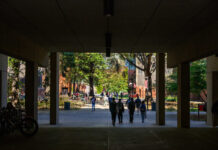But it was.
The violence put the street on the map for local civil rights history. And that’s why it is among 21 stops on a new self-guided driving tour developed by the University of Louisville’s Anne Braden Institute for Social Justice Research (ABI).
The Wades were African Americans. They had one small child and another on the way, and wanted a home with a yard where their children could play. While they had come close to purchasing a nice, suburban ranch home before, the deals had fallen through when their race became known.
At the time, deed restrictions and lending practices in Louisville kept black families from being able to buy homes in much of the city, according to UofL associate history professor Tracy K’Meyer in her book Civil Rights in the Gateway to the South: Louisville, Kentucky, 1945-1980.
The Wades needed help to purchase the home of their choice and turned to a white couple, the Bradens, activists in Louisville’s civil rights movement.
Since the Bradens worked with the black community to end segregation and with other like-minded white friends and colleagues, however, they were out of touch with the pervasive support in Louisville for segregation, wrote UofL associate professor and ABI Director Cate Fosl in her book Subversive Southerner: Anne Braden and the Struggle for Racial Justice in the Cold War South.
And even though there was an African American neighborhood a quarter of a mile away from the home they purchased, they had crossed a line – so much so that authorities shifted blame from the perpetrators of the violence to the Bradens and Wades, Fosl said in Subversive Southerner.
The people who threw rocks through the Wades’ windows, shot into the house, burned a cross in the yard – and bombed the house – never came to justice, Fosl said. Instead the legal system accused the Bradens of being Communists. Carl was tried for sedition and sentenced to 15 years in prison and a $5,000 fine. His conviction was reversed in 1956 after the U.S. Supreme Court ruled that all sedition laws were unconstitutional.
Tying the incident to Communism diverted attention away from the real issue at hand – the inability of a black family to live peacefully in the home of their choice, K’Meyer said recently, and the violence and legal harassment that confronted the Wades and Bradens stifled the movement for residential integration for almost a decade. In fact, she said, housing segregation worsened.
Louisville has yet to realize the integration it might have experienced if the movement to more fully integrate its neighborhoods had progressed uninterrupted, both Fosl and K’Meyer said.
There are few better instances in all of U.S. history that so dramatically demonstrate how Cold War ‘McCarthyism’ — that anticommunist hysteria that made all dissent seem suspicious — helped white southerners who wanted to uphold legal segregation at the same time that federal actions were in the process of slowly dismantling it, Fosl said.
McCarthyism propped up racial segregation by questioning the loyalty of those who opposed it, she said.
The Wade home never was rebuilt, but motorists can learn of its role in Louisville’s civil rights movement from a historical marker on the street. Markers provide information at several stops of the ABI driving tour.
One goal of the tour, Fosl said, is to provide a wider understanding of our local history and how it connects to regional and national experience.
Louisville’s civil rights movement was similar to those in other communities in the type of participants it drew. Their tactics – direct action, boycotts, use of the political system and persuasion – also were similar to those used in other communities, K’Meyer said.
But in Louisville, she continued, there was no one dominant organization, strategy or personality.
Fosl said tour developers also want those who take it to understand more fully what life under past racial restrictions was like and why and how African Americans and their white allies organized together to change laws and practices. It is a way to more solidly anchor the events and places in local memory and to give visitors a fuller picture of what Louisville was and is today.
We want to honor the movement’s leading participants in particular, but also to lift up the importance of collective struggle in bringing about needed improvements to our city, she said.
And, as in the case of the Wade dynamiting, to come to terms with what Fosl said the civil rights movement did not achieve.
We still have a lot of work to do to achieve true racial justice in the United States and in Louisville today, Fosl said.
Brochures of the driving tour are available at ABI, on the second floor of Ekstrom Library on Belknap Campus. More information on the Wade incident, including books confiscated from the Braden home and used as evidence of their Communist involvement, are on display at the institute.


























